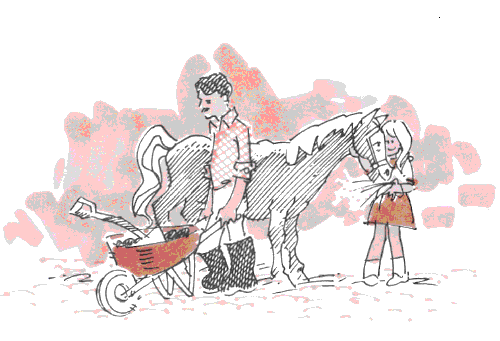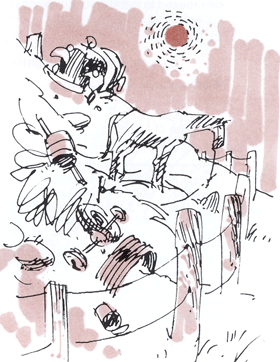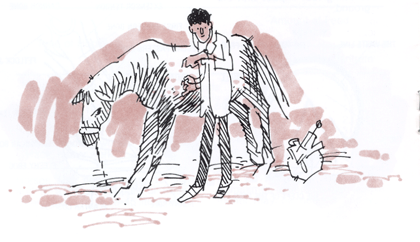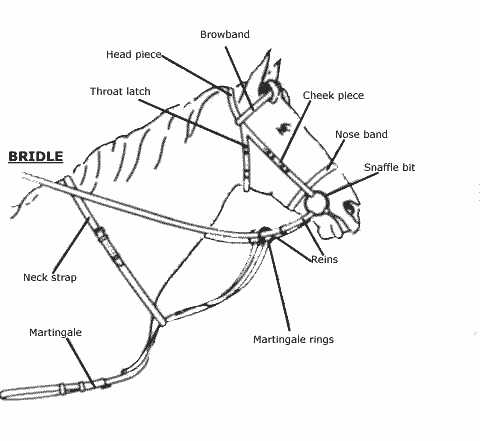
Caring for horses
Foreword
The horse is a marvellous athlete and a delightful companion animal. However, horses are not always cared for properly, even by well-intentioned owners.
This document is designed to help you with information about the proper care and use of horses. It has been endorsed by the NSW Animal Welfare Advisory Council and the Australian Equine Veterinary Association.
Horse Care
Many horse owners, particularly those who are inexperienced or are caring for a horse for the first time, sometimes encounter problems that cause anxiety and may even distress the whole family. What follows is a very brief outline of horse care; most of which also applies to donkeys.
Responsibility
Owning a horse or donkey is a big responsibility. It means hard work and often unpleasant chores for a long time; and it usually also means quite a considerable expense.
It is very important to understand that the initial purchase of your horse is only the first step in a whole new experience. You will have to consider whether the horse can be kept in a paddock, or whether it will be stabled. You need to know about feeding and its likely costs. Paddock horses may need some supplementary feed when grass becomes eaten down, and stabled horses need to be fed continuously on bought feed.

You will need a bridle, saddle, saddle blanket, grooming brush, feed tin and water container. It is a good idea to ask about the cost of these items first as they can be very expensive unless you take time and care in their selection. Remember that a safe storage area is needed for your equipment when it is not being used on the horse.
These are the basic necessities for your horse. Your own riding outfit has to be purchased as well, and this must include a suitable helmet and good quality riding boots.
There will also be fees for shoeing, for regular preventative measures against diseases such as tetanus and strangles, and for worm control. The possibility of unexpected expense because of illness or injury should be remembered.
Choosing your horse
If this is your first horse, a person with a good knowledge of horses should go to inspect the horse with you. Make sure the person selling the horse knows the use you have in mind for the horse.
Be wary of unbroken horses.
Don’t rush in and buy the first horse offered. If you are buying a riding horse, arrange to ride it yourself on a number of occasions; if you cannot ride, have a friend ride it for you. Make sure it is free of serious vices such as biting, kicking, rearing, bucking or bolting. If you are satisfied you have found ‘your’ horse, then it is extremely worthwhile to have an experienced horse vet check ‘your’ horse out and then discuss with you anything about the horse that you are unsure of.
The new horse owner
A commonsense approach to horse ownership is best for you and your horse. Remember the following important aspects of good horsemanship:
- Provide only good quality feed.
- Always have clean, cool water available for your horse.
- Do not work your horse immediately after a heavy feed.
- Always clean your horse’s feet before and after riding to prevent foot injury from stones, sticks or metal objects that may have become embedded in its feet.
- Make sure your saddle is kept clean, the girth is cleaned and that the saddle blanket is washed regularly.
- Always check your saddle for pressure areas due to shifting lining, packing, or dried leather girths or saddle flaps.
- Never work your horse for long periods until you have properly conditioned the animal through slower regular workouts.
- Remember that horses have good memories—they can learn bad habits as easily as good ones.
- Register yourself as a client and your horse as a patient with the veterinarian of your choice. He or she will be able to advise you on a regular program for worm control, vaccinations, and tooth and foot care.
Where will I keep my horse?
Ideally, your horse should be kept in a paddock of 1 hectare (minimum 0.4 hectare). The paddock should have some natural shelter, good grass cover and drainage.

The paddock should be:
- properly fenced (not with barbed wire) and with the fence easily seen by horses;
- free from all rubbish, especially old wire and iron;
- close enough to home to permit daily visits;
- kept free of droppings in order to discourage flies and aid in worm control;
- suitable for catching and working the horse.
Horses need shelter from heat, wind and rain. Natural shelter such as a belt of trees or a hedge is suitable, but you may prefer to provide a stable or shed to supplement or substitute for natural shelter. Stables should be at least 2.5 metres high and should have a floor area of at least 12 square metres (for horses) or 9 square metres (for ponies and donkeys). They must be constructed and maintained to be secure and to minimise any risk of injury. Good drainage and ventilation are needed, and fire fighting equipment should be kept close at hand. Clean bedding, such as straw or wood shavings, should line the floor of the stable and must be changed regularly and often.
Remember that old horses need special care and should have a warm waterproof rug in addition to other protection from the elements.
Horses need exercise
Tethering is not an acceptable method of keeping horses. Also, horses are sociable animals and don’t like to be kept in isolation for long periods.
Before you decide where to keep your horse, check whether your local council has any special requirements. Many councils set particular standards for paddock size, type of stabling, drainage and waste disposal. People living next door to your horse should also be considered—don’t allow the keeping of your horse to become a nuisance to others. If your horse is being cared for by other people, or if you are not able to visit it every day, make sure that a responsible person who sees your horse daily is able to contact you in an emergency, or summon veterinary assistance on your behalf.
How do I feed my horse?
Your horse should be fed to maintain body condition, and should not be allowed to get too fat or too thin.
Good quality grass is the simplest and most natural feed. Where good pasture is available and the horse is not ridden regularly, there is probably no need to for supplementary feeding. However, when pasture declines additional feed will be required to maintain bodyweight.
Hay and concentrates are suitable for this purpose.
Good quality lucerne or legume/grass hay is adequate for adult horses that are idle or ridden infrequently.
Young growing animals, lactating mares, and hard working horses require more energy. This is usually supplied by feeding concentrate supplements such as grain or a complete pellet.
It is best to feed little and often (2-3 times daily) and feed plenty of bulk, such as good quality hay.
The following table is a guide:
| Amount of Feed kg/day | |||
|---|---|---|---|
| Type of Horse | Work | Hay | Concentrate |
| Pony under 12 h | Ridden w/ends | 1.5-3.0 | 0.5 |
| Pony 12/14 h | Ridden w/ends | 2.0-4.0 | 1.0 |
| Pony under 12 h | Ridden daily | 1.5-2.5 | 1.5 |
| Pony 12/14 h | Ridden daily | 2.0-3.5 | 2.0 |
| Hack, light work | 1-3 hrs/day | 3.0-6.0 | 3.0 |
| Hack, medium work | 3-5 hrs/day | 4.0-5.0 | 4.0 |
| Hack, heavy work | 5-8 hrs/day | 4.0-5.0 | 5.0 |
Horses also need access to salt and to a regular supply of fresh clear water—up to 25–45 litres daily may be needed in hot weather. Sometimes other mineral supplements may be needed and your veterinarian will be able to advise you further on this.
Transport
Horses are prone to injury during transport. If your horse is not used to being transported it should travel only in the company of other horses. In all cases it should wear a head stall with the lead tied with a quick release knot to the vehicle. Do make sure before loading your horse that the vehicle is sound and that your horse can be fastened in securely.
Foot care
An old but true saying runs ‘no foot, no horse’.
A horse’s foot has three parts:
- Wall: this is the part you see when the foot is on the ground.
- Sole: this protects the foot from injury from below. It isn’t very thick and riding over stones will cause lameness due to bruising of the sole. The sole should not touch the ground.
- Frog: this is the firm elastic structure at the rear portion of the foot. It absorbs concussion following foot impact with the ground.
Every time a horse is handled its feet should be inspected for damage or soreness and particularly for stones or glass embedded in the frog. If the animal is shod a check must be made for stones between shoe and frog and for looseness. A hoof pick should be used to clean the feet.
Horses to be ridden on roads or rough ground or to be given heavy work should be shod. Shod horses should be inspected at least every six weeks for replacement or adjustment of shoes. Hot shoeing should only be carried out by an experienced farrier.
Unshod horses should have their hooves trimmed, if necessary, every 8 weeks.
Teeth
Horses aged 2–5 years of age should have their teeth examined prior to commencement of work or at 6–monthly intervals. Horses should have their teeth checked at least once a year after reaching the age of five. A horse with bad teeth cannot eat properly and is likely to lose condition or be difficult to ride. Regular veterinary attention will make sure that your horse’s teeth are in good shape.
Health of your horse
Every horse owner should learn to assess the condition of their horse and to observe the first signs of illness so that professional veterinary aid may be called.
A horse in good health is active, moves freely, eats and drinks freely, has a clear eye and nose, a clean skin and coat, and good general body condition without being too fat.

Prevention is better than cure and some problems are difficult to correct once they do occur. As a guide, your vet must be consulted immediately if your horse shows:
- acute abdominal pain or ‘colic’;
- serious injury, including deep wounds, severe haemorrhage, suspected bone fracture, or damage to eyes;
- straining for more than 30 minutes by a foaling mare;
- inability to rise or stand.
Veterinary assistance should be sought as soon as possible if your horse has:
- marked lameness or injuries not responding to treatment within 24 hours;
- persistent signs of a cold, accompanied by loss of appetite;
- severe diarrhoea or persistent weight loss;
- persistent skin conditions.
Common health problems
Colic This means abdominal pain and it can occur at any time. The signs are restlessness, patchy sweating, pawing, looking at flanks, lying down, rolling and lying on the back or assuming a dog-sitting position. The most common causes are sudden change of feed, worm infestation, sand impaction, spoiled feed or bad teeth.
Such a horse needs prompt attention and should be slowly walked and kept warm until the vet arrives.
Tetanus
Tetanus is a serious disease that can affect all domestic animals. Horses are particularly susceptible. Tetanus spores, which occur in soil, enter the tissues of the animal through wounds. The type of wound commonly infected is the deep puncture which may be caused by penetration of a splinter or a nail. Crushing wounds are also dangerous. However, some cases of tetanus commence from wounds that are so small that they are not noticed.
An affected horse becomes stiff in its movements, the ears are pricked, and the tail is held out stiffly. Generalised muscle spasms may then occur and death results from paralysis of the breathing muscles.
Tetanus is difficult to treat, and even with intensive veterinary care the chances of saving the horse are slight. Tetanus can be easily prevented by vaccination.
For full protection, a horse is given a course of 2 injections at a 4-week interval, and a booster injection within 12 months. A booster dose every four or five years thereafter will maintain continuous protection.
If your horse is not vaccinated and it suffers a wound, veterinary attention should be sought immediately.
Strangles This is a highly infectious bacterial disease of the upper airways of horses. Outbreaks of the disease may be expected in groups of horses where there is a changing population. Animals taking part in gymkhanas and pony club activities may also be exposed. Cold weather and poor ventilation assist the spread of the disease.
Although common in young animals, it occurs at any age. The disease is characterised by cold-like symptoms with fever, nasal discharge, depression and reluctance to eat. Hot, tender swellings develop in lymph glands, usually around the head, jaw and neck, as a result of abscess formation. These often rupture and discharge a thick, creamy-yellow pus. Most horses recover but the infection can cause death or chronic illness.
Vaccination, involving an initial and then yearly boosters, will assist in the control of strangles. Discuss vaccination of your horse with your vet when planning to visit shows, gymkhanas, etc.
Common Cold This viral disease is highly infectious, particularly in young horses. The horse typically has a watery discharge from the nose at first, but this gradually becomes more white or grey, and may even become quite a thick pus discharge. Keep the horse warm, and stop working it. Feed moistened feeds since a sore throat is often associated with the problem. If the horse shows signs of sickness other than the runny nose and slight cough, you should contact your vet.
Worms
A regular treatment programme to control worms is necessary to maintain your horse’s health. The frequency of this treatment is regulated by the horse’s age, whether it is continually stabled, in a small yard or a paddock, and whether it is running with a number of other horses.
The younger horse needs frequent treatment to keep the large white round worm (Ascarid) under control.
However, the most serious worm problems are related to the so-called red worms, or strongyles. The larvae (early stages) of red worms are probably responsible for at least 90 per cent of all colics that horses suffer. In severe infestation, they can cause the death of your horse. Large numbers of adult worms cause anaemia.
Control is based on paddock hygiene and worm treatments.
Paste wormers are satisfactory if the correct drug is used at the correct dose and the treatments are sufficiently frequent. You should consult your vet about the best treatment regime for your particular horse. Medication alone does not give enough protection and you will also need to remove manure regularly from paddocks, keep feed off the ground in racks or feed bins, and segregate animals by age groups.
Bot Flies Bot fly eggs, laid on the horse’s coat, are hatched by the moist warmth of the horse’s mouth rubbing to relieve the irritation. After hatching, the larvae burrow through the lips and gums and migrate into the horse’s stomach. If large numbers are present, indigestion, poor appetite, and colic can occur. Eggs are found mainly on the legs and abdomen. They adhere strongly to the horse’s hair and should be cut off with scissors and burnt. You should discuss treatment for bots with your vet when discussing worm control.
Lice Lice infestation occurs throughout Australia and reaches a peak in late winter and spring. Horses with long heavy winter coats are more prone to heavy infestation. Biting lice are usually found on the back of the body and head. Sucking lice are generally found under the mane, tail and fetlocks. Horses with heavy infestations of sucking lice can become anaemic.
Lice cause intense itching and irritation of the skin as well as loss of condition. Horses bite and rub the skin, causing the hair to fall out leaving red, weeping areas. Your vet can advise you on suitable sprays or powder insecticides which can be used to treat horses. Rugs and harness should also be sprayed and left unused for 14 days. A second treatment 17 days after the first treatment is advisable.
As well as lice, horses are susceptible to a wide range of other skin conditions. Due to their variety a correct diagnosis is essential to their proper treatment. Early veterinary advice can reduce the likelihood of incorrect treatment.
Lameness Lameness may occur suddenly and affect one or more limbs. In very acute cases a horse may be unable to move more than a few steps. Foot abscesses due to nail pricks or stone bruises can cause acute lameness. Laminitis or founder, which is a frequent cause of lameness in an excessively fat horse that does not receive regular exercise, should receive urgent attention. Sudden changes of food may also cause this condition.
Never ride a lame horse. If even slight lameness is observed, dismount and lead it.
Other problems with horses
The person best trained to assist you with your problems is your vet. Be sure to consult with him or her when doubt exists about the correct treatment of your horse or when problems arise.
Equipment
Selection, care and use
Good well-fitted leather saddlery is expensive, but if it is regularly used, cleaned and oiled it will last a long time. It must be inspected often for defects and any roughness should be remedied promptly. Good quality equipment is a wise investment.
The saddle should not press on the horse’s withers as saddle sores may result.
The saddle cloth needs regular washing to keep it free of dried sweat. Make sure it lies flat over the horse’s ribs without creases, and lift it at the back and front into the channel of the saddle to allow airflow along the horse’s spine.
Keep the girth strap soft and free of dried sweat; tighten it gently until it is firm, not pinching the horse, and safe for the rider.
When fitting the bridle, make sure the bit is in just tight enough to cause a slight dent in each side of the mouth. The throat lash should be adjusted to allow absolute freedom to breathe; two fingers’ width is usually enough.
Rugs should fit well, be warm and waterproof; repair and re-waterproof immediately after each winter.
Don’t forget to wear a suitable helmet when you are riding.
After riding
Before allowing a horse to drink, take off its saddle, and lead it around until it has cooled down, then allow a small drink with another in about five minutes.
After a workout the horse will need a good rub down. Sponge off sweat in winter and wash well in summer, with special attention being paid to the areas aroung its ears, the girth and between its hind legs.
Donkey care
All points mentioned for horse care apply to donkeys. They are able to manage on natural grass very well, and only require adequate grass to keep healthy. However, if grass becomes limited, they should be supplemented as advised for horses.
Coarse native grass, paspalum and even less lush grasses will keep a donkey happy. Carrot tops, apples, bread and selected kitchen scraps are acceptable, but meat, rhubarb leaves, rhododendron, wheat or grass clippings are NOT acceptable.
A plentiful supply of clean water is essential. Supplementary feeding is necessary when no natural pasture is available.
NOTE: Donkeys need roughage so provide hay if natural roughage isn’t available. A salt lick must always be provided. Mineral salt licks are the best.
Company Donkeys need and must have company. A visit once a week is not enough.
Feet Donkeys are not generally shod but their feet need occasional trimming. Inspect feet regularly, check for stones before and after riding and depending on growth rate, arrange for a farrier to call about every two months.
Roll patch Donkeys love rolling; either put up with a bare area in the paddock, or provide a sand heap.
Education A trained donkey will be a happy one. It should not be ridden until three years of age, but preparation should begin much earlier by teaching it to lead and to go in and out of a float. Always be patient and encouraging. It is a good idea to visit a few shows to see donkey handling at that level, riding, pulling a cart and so on.
Remember
- Donkeys are intelligent, need discipline, company and routine. They get on well with other donkeys but a young one should be introduced through the fence before being put into a paddock with others.
- Don’t allow a jenny to foal until three years of age.
- Donkeys are hardy animals so long as the basic needs are provided. Don’t spoil your donkey, but you will be repaid over and over again for your efforts to look after your donkey properly, i.e., grooming, foot care and patient training.
A great deal of excellent reference material on horse care is available in the horse section of the NSW DPI web site.
See also: Land Transport of Livestock

